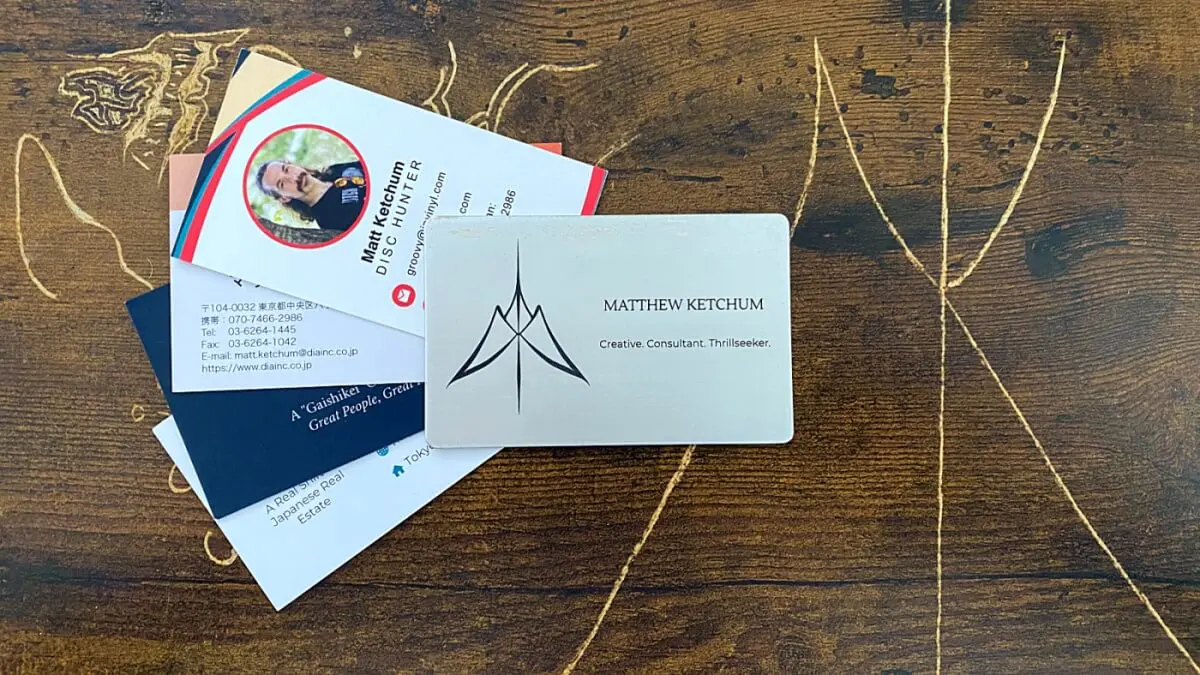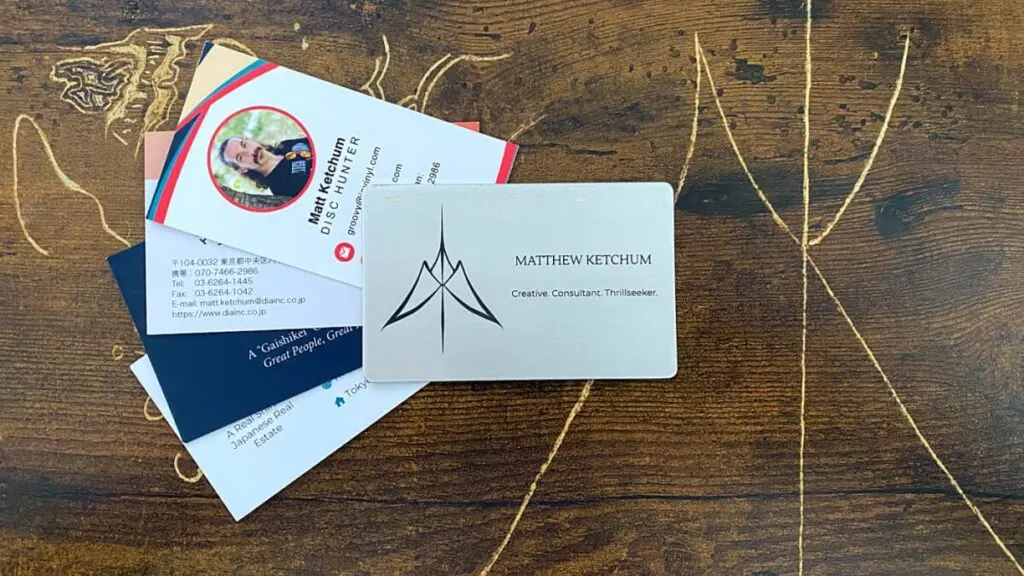V1CE Metal NFC Card: A New Signal in an Old Format
Japan’s got an unfortunate ritual of rarely changing anything from what always has been. Exchanging business cards is one of those things, and it hasn’t changed much in decades.
The accepted process is formal. Codified. You offer your card with two hands, eyes low, and receive theirs with reverence, as if each card were a small contract signed in silence. Frequently, the design is boring. Often, you’re expected to do this dumb “lemme inspect this like it’s fine art” thing. Usually, the whole act is totally unnecessary because their business is outdated. Reverence doesn’t mean relevance.
To be fair, I still collect most cards so that I can connect on Linkedin (if they have an account) and then shove them into my mailing list. After that? Shredder. This is a ridiculous set of steps to accomplish what the V1CE metal NFC card does in one fell swoop while also setting you apart from others. It doesn’t ask for reverence. It asks for recognition, because it isn’t just a card. It’s a live interface that reflects who I am now, not who I was when I hit “send to printer.”
I still carry paper cards, because I know where I am and what’s expected. But that’s not the same as liking it. The V1CE card doesn’t replace tradition with arrogance. It bends it just enough to make space for the future. A touch of steel in a culture of pulp.
What a Card Feels Like When It's Actually Meant to Last
The first thing people notice is the visual weight. That brushed metal finish, sharp in presence, and millimeters thick. It’s monolithic compared to anything else in the category. Through it, you don’t just hand over your contact information, you broadcast it from The Beyond.
And that’s exactly how I want things to be. My gear, my look, even my words, they’re not decoration. They’re alignment. I’ve written about that before: style is structure. The card fits in the same system that houses my bags, my sunglasses, my shirts. Each object I carry is chosen, not just owned, and similarly the V1CE card wasn’t a whim but a necessary addition to my evolving style.
Identity That Updates Like a Feed, Not a File
I guess back in the day you became one thing early in your career and climbed that ladder for your whole lift. Hell, in Japan, that’s still blindingly common. If that’s who you are, then, yeah, you should probably have a boring personal brand.
But if you endeavor on another path, a business card shouldn’t fossilize your identity. It should be flexible, reflective, alive, to communicate that journey. The V1CE card understands that. Their management app is clean and intuitive app, and I can update where the card points—my site, my current project, a Notion client portal, a landing page, a time-limited booking link. I’ve even used it to launch tour announcements and redirect to pre-release drops for my band Worship Pain.
This makes it more than a convenience. It’s a strategic layer in how I present myself. In one interaction, I can tailor what someone sees without changing my tone or behavior. No reprints. No wasted time. Just a single object that morphs as fast as I do.
In Japan, This Isn’t Just Futuristic. It’s Friction
Japan runs on analog culture masked by digital gloss which is itself aging. The infrastructure is pretty good:
- Japan has been working with fiberoptics since the early ’90s.
- It has robot restaurants and hotels (but really aren’t these jsut adult themed Chuck-E-Cheese?)
- Can’t forget the famous bullet train (opened in the ’60’s)
and the country’s branding is high-tech, but the reality on the ground, for both business and culture, remains extremely, pathetically analogue. People still fax. Still print. Still sign things with ink and stamp. Using a digital business card in Japan isn’t just modern. It’s unexpected. But that’s the point.
When I bring out my V1CE card in an introductory setting, I don’t break protocol; I bend it. The card is still offered with two hands, still treated with respect. But what follows isn’t small talk or empty exchanges. They tap or scan the QR code. Their phone lights up. And their face changes. Curiosity enters. The script blurs. The transaction is done.
I’m not doing it to be cool. I do it because someone has to model a better path. People here don’t want to be first, but they’ll follow if the first move is graceful. This card is that move.

Sustainability Without Softness
Yes, this is a sustainable business tool, and that’s cool even though I don’t really believe in sustainability without… well, that’s another conversation to be had very much offline. Regardless, though, sustainability is so often characterized by things that aren’t, what, full of energy. Vital. Which now that I think about it , is kind of odd – isn’t sustainability supposed to be about life and vitality? Why shouldn’t it be locked, loaded, and ready to go?
Well, fortunately enough, we’ve got V1CE. This thing can’t be confused with softness or smugness. It’s a problem solving tool that makes you the hero of the planet, if only for a split second. I rarely print new cards, and so I’ve almost ceased contributing to business card landfill. But more than that, I’ve opted out of redundancy, and opted into technology.
One card. One object. Unlimited updates. That’s sustainability not just as ecology, but as design intelligence. The card doesn’t preach. It works. And in that quiet utility, it says more than any recycling badge ever could.
The Card That Changes the Conversation
Something subtle shifts when you lead with the V1CE card. The conversation tilts. People skip the small talk. They ask about the card, about the project it links to, about the decision behind using it. They realize, without having to be told, that I’ve made intentional choices.
It’s a form of modern personal branding that doesn’t feel like branding. It feels like presence. The kind that sticks. Because while anyone can look polished, very few look precise.
From Preference to Presence
There are spaces in Japan where paper is still the expected medium. I bring those cards. I offer them when needed. But they’re no longer my default. They’re backup. The V1CE card is the one I prefer, the one I trust to tell my story with clarity and frictionless functionality.
And it’s not just the medium that changes. It’s the message. When you lead with something like this, the conversation tilts. People ask different questions. They engage on a deeper level. They skip the small talk and go straight to the source. The V1CE card doesn’t just help me share contact info. It helps me share intention. And that creates a presence that sticks.
It’s not about abandoning old forms entirely. It’s about showing that there’s a smarter option, and modeling that until it’s no longer strange. Sometimes the best way to preserve tradition is to find the future it can still thrive in.
V1CE: Stand Out From Your Card
The V1CE metal NFC card isn’t about flash or convenience. It’s about committing to a new kind of interaction—one that’s adaptable, memorable, and intentional. It sits at the intersection of ritual and recursion, of etiquette and edge.
If you’ve ever felt boxed in by the tools you were handed, if you’ve ever wanted to show up as a real-time version of yourself rather than a snapshot, this card is your starting point. Not because it replaces tradition. But because it reminds us that tradition is only useful when it can evolve.

